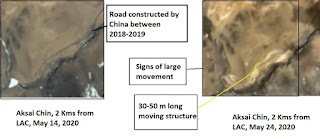Can India Match China’s Manoeuvres in COVID era?
When
the world is fighting COVID-19, the current stand-off at the Galwan River
Valley in Ladakh has struck hard the India-China relations once again. China is
giving India a tough and complex challenge politically, strategically,
economically and environmentally. China’s military and economic clout provides
it better prospects in international community where India has to struggle hard
to make its presence felt. We have no military strategy to find amicable
solutions towards China’s provocative and coercive military tactics. While
safeguarding its territorial and strategic interests, India is yet to hone up
its diplomatic skills while China advance its strategic objectives through
coercion, military might trying to eliminate the perceived threats to its
interests.
The current stand-off at the Galwan River
Valley in Ladakh, in the disputed Kashmir region, for instance believed to
have started on 5 May 2020 is prompted by a road that branches off from the all-important
255 km Darbukh-Shyok-DBO (DSDBO) road, which is India’s mainstay on the
Leh-Karakoram axis. While Indian troops have been patrolling up to the point,
the effort now is to improve road access and regularize presence. This is
unacceptable to China, which is keen to retain ability to deny India any sense
of comfort on security of the DSDBO road. Hence, the stand-off.
China is quietly pursuing its diplomacy
and deploying pressure tactics, sometimes which is hard to decipher. In the
aftermath of the 1962 Sino-India war, there have been scattered diplomatic
flare-ups and unauthorized excursions since then. Tensions between China and
India over their Himalayan border have always escalated, with China accused of
moving thousands of troops into disputed territory. This is because India and
China share a border more than 3,440km (2,100 miles) long and have overlapping
territorial claims. The same was highlighted in an article dated 2013 “Can
India Match China’s Manoeuvres”, published in the May 2013 issue of the Third
Concept Magazine, the link is attached for your kind perusal. Military
delegations from both sides met again to try and resolve the standoff, but have
failed to break the deadlock. Perhaps, after India’s move into Doklam with a 73-day
standoff at Doklam, the tri-junction region where India, China and Bhutan meet
in 2017, China is perhaps especially sensitive to any Indian activity along the
disputed border and also claiming Mount Everest as its own. Amid tension with
India, Nepal restarted its work this May 2020 on border road after 12 years to
facilitate trade with China. These incursions occur couple of times that
reflects its hidden agenda or display a competitive urge to shape the world of
the 21st century with its GDP of $14.4 Trillion (2019).
If we look to the South China Sea,
Chinese methodology is carefully planned with willful disobedience. China’s
interests in South China Sea are seen suspicious while India has always
maintained free right of movement in international waters and sea lanes of
communication. Further, disputes also extends to environmental dimension with
water sharing concerns and infrastructural incursions along the Tibetan plateau.
India-China has also shown cooperation at
WTO seeking trade benefits for developing countries, BRICS or ASEAN+10 regional
groupings and people-to-people cultural contacts. However, competition and
mistrust since decades have casted a long spell on their relationship leaving
behind the cooperative avenues. Given the present crisis, India can ill-afford
to confront China militarily and such a move may not be in our national
interest as well. Isn’t it re-balancing the regional security?
Against such backdrop, the ethos of Aatma
Nirbharta, underlined by our Hon’ble Prime Minister of India is ringing in true
spirit in the light of COVID-19. In such a scenario, apart from army’s
responsibility, it is the people’s duty to join hands together to fulfill their
responsibility against the India-China crisis. Can the ‘Paanch Tatva of
self-reliant India’ standing on five pillars of ‘Economy, Infrastructure,
System, Demographic Dividend and Demand’ unleash a potential towards Make in
India 2.0?
Image source - India Today




Comments
Post a Comment